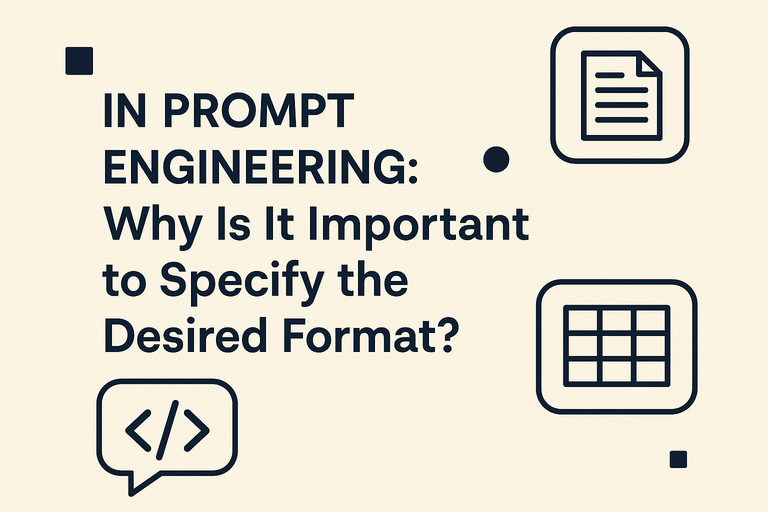In Prompt Engineering: Why Is It Important to Specify the Desired Format?
Estimated reading time: 5 minutes
Key Takeaways
- Specifying the desired format enhances clarity and reduces ambiguity in AI interactions.
- Clear format instructions lead to consistent and high-quality AI outputs.
- Proper format specification streamlines workflow integration and saves time.
- Following best practices in format specification maximizes the benefits of AI prompt engineering.
The Power of Format Specification
In the rapidly evolving field of artificial intelligence and prompt engineering, one crucial aspect often determines the success or failure of AI interactions: specifying the desired format. As AI technologies become increasingly integrated into our daily workflows, understanding why format specification matters has never been more critical. Let’s dive deep into this fundamental aspect of prompt engineering and explore why it’s a game-changer for achieving optimal AI responses.
Consistency: The Golden Standard
When interacting with AI models, clarity is king. According to leading AI experts at Lakera, specifying the desired format is not just a mere suggestion—it’s a foundational element that can make or break your AI interactions. Think of it as providing a blueprint to the AI; without it, you’re essentially asking the AI to build a house without architectural plans.
Clear format specifications eliminate ambiguity in AI responses. As highlighted by Akooda and Learn Prompting, vague or underspecified prompts force the AI model to guess user intentions, often leading to misaligned or inconsistent outputs. For instance, a simple request like “summarize this” could result in various interpretations—from dense paragraphs to bullet points or even single sentences, depending on how the model processes the request.
Quality and Accuracy: Raising the Bar
“Better prompts lead to better outcomes”—this mantra from OpenAI encapsulates why format specification matters. When structure, style, and output guidelines are precisely set, the likelihood of receiving high-quality, actionable responses increases significantly. Well-formatted prompts ensure:
- Summaries adhere to requested lengths.
- Lists follow defined markdown syntax.
- Analyses maintain consistent templates.
- Outputs match predefined quality standards.
According to ChatPromptGenius’s optimization guide, specifying the desired format helps in achieving more accurate and relevant results.
Efficiency and Workflow Integration
Time is a valuable resource, and format specification helps conserve it. OpenAI and Learn Prompting emphasize that proper format specification can save users and developers considerable time that would otherwise be spent reformatting outputs or clarifying instructions through multiple iterations. Moreover, as noted by PromptLayer and Lakera, streamlined formatting simplifies the integration of AI-generated responses into:
- Automated pipelines
- Reporting tools
- User interfaces
- Data processing systems
Integrating AI outputs becomes seamless when the format is consistent and predictable, as detailed in the Mastering ChatGPT API Automation guide.
Best Practices for Format Specification
To maximize the benefits of format specification, industry experts recommend several key practices:
1. Prominent Placement
Place format instructions at the beginning of prompts, making them immediately visible and actionable.
2. Clear Separation
Use distinct separators or sections to differentiate between:
- Task description
- Context
- Output expectations
3. Example-Driven Clarity
Provide explicit examples within the prompt to demonstrate the desired output structure. This practice is particularly effective for complex formatting requirements.
4. Specific Constraints
Clearly state output constraints, including:
- List length requirements
- Markdown usage guidelines
- JSON schema specifications
- Numbering or bullet point preferences
Real-World Implementation
Consider this example from PromptLayer for effective format specification:
TASK: Summarize the following text in 3-5 bullet points.
CONTEXT:
[Text content]
INSTRUCTIONS:
- Focus on main ideas
- Use concise language
- Maintain original tone
OUTPUT FORMAT:
Provide summary as a list of bullet points, each starting with a dash (-)
The Impact on AI Interactions
The importance of format specification in prompt engineering cannot be overstated. As confirmed by multiple industry leaders including Lakera, Akooda, and OpenAI, proper format specification:
- Significantly reduces ambiguity and misinterpretation
- Enhances the consistency and quality of AI outputs
- Streamlines workflow integration and processing
- Aligns with industry best practices and standards
For more detailed strategies, refer to the Prompts for ChatGPT Guide.
Conclusion
In the evolving landscape of AI and prompt engineering, format specification stands as a cornerstone of effective AI interaction. Whether you’re a developer, business user, or AI enthusiast, understanding and implementing proper format specification in your prompts will significantly improve your AI interactions’ quality, consistency, and efficiency.
By taking the time to clearly specify your desired format, you’re not just improving individual interactions—you’re building a foundation for reliable, scalable, and effective AI implementations. As AI continues to integrate deeper into our professional and personal lives, mastering this aspect of prompt engineering becomes increasingly valuable for anyone working with AI technologies.
Learn more about prompt engineering at ChatPromptGenius’s Learning Guide.
FAQ
Why is specifying the desired format so important in prompt engineering?
Specifying the desired format enhances clarity, reduces ambiguity, and ensures that AI models produce consistent and high-quality outputs that meet user expectations.
How does format specification improve AI workflow integration?
Properly formatted AI outputs simplify integration with automated pipelines, reporting tools, and data processing systems, saving time and resources.
What are some best practices for format specification?
Best practices include placing format instructions prominently, using clear separation between instructions and context, providing examples, and stating specific output constraints.
Where can I learn more about effective prompt engineering?
You can learn more by visiting the Learn Prompt Engineering Guide on ChatPromptGenius.
